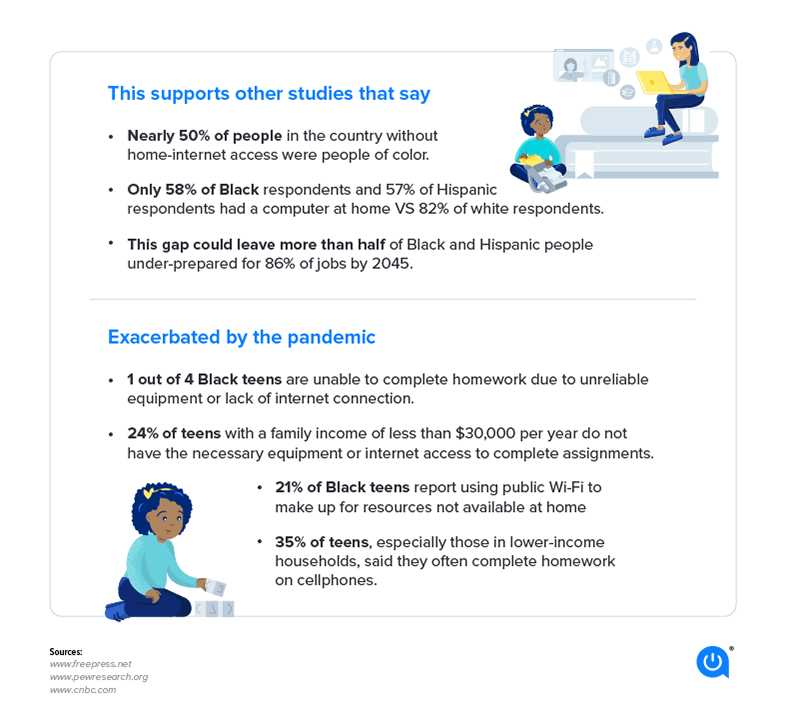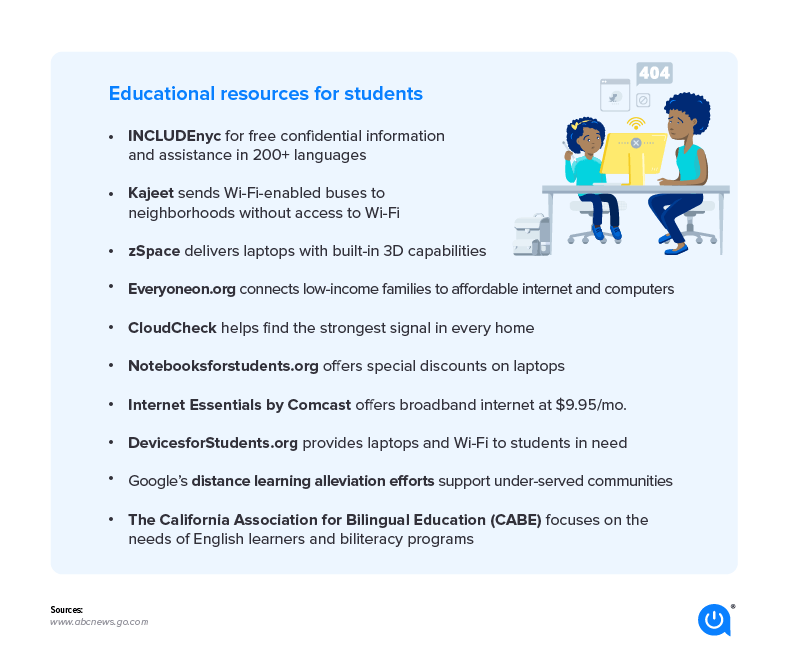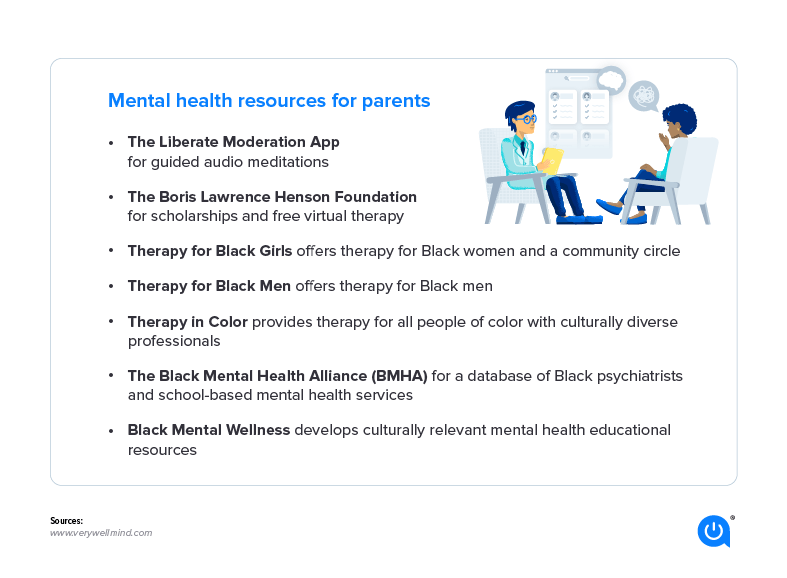The recent pandemic-driven shift toward a greater focus on digital education has had far-reaching impacts. With the pandemic forcing societies to reevaluate how education is delivered, not all students are equally well-equipped for the new trend of virtual and hybrid learning.
For instance, roughly nine million students don’t have adequate technology or internet access for effective virtual learning. Of these students, a disproportionate number are people of color.
Although unintentional, the shift to online learning has created a racial divide in education access. This segment of the digital divide is causing some students to fall further behind their peers. While resources for parents can help, there are often barriers beyond knowledge and skill.
The digital divide and impact on Black students
Throughout American history, there have been racial disparities in the education system. From segregation in the first half of the 1900s to modern technological barriers, the education system has been one of unequal access. Activists, parents and students have fought, protested and voted to make incremental changes to this system of inequality. The current digital divide is only the newest barrier in this pursuit.
Black families face a complicated problem in the modern education system, especially with the current trend for digital learning.
They are more likely than others to live in remote-only school districts, yet less likely to have the necessary resources to succeed at remote learning. Not only does a lack of computers and internet access enhance this problem, but parents of Black children are less likely to be able to work from home or to afford childcare. This scenario creates something of a Catch-22 that is all too common in lower-income groups.
Financial inequalities can become somewhat self-perpetuating in a society when the necessities of daily living preclude lower-income families from investing in their family’s future. When that means not being able to help their children meet their educational needs, it can contribute to generational poverty. Black students are disproportionately impacted by accessibility, usability, affordability and quality of education.

The internet accessibility gap
An accessibility gap is how easy it is for one group of people to access something relative to another group. For instance, the average difference in speed, quantity and quality of devices that can access the internet (as well as internet access itself) between white and Black families.
Internet, connectivity and providers
Access to the internet presents one clear example of an accessibility gap. Based on a study performed by Allconnect, Black respondents were three times as likely to be without internet access as white respondents. Not only that, but the same survey found that of Black respondents who had internet access, they were more likely than white respondents to have internet speeds under 25 Mbps.
In the world of digital learning, internet access and speed are essential for maintaining access to quality education. Not only do slow speeds interfere with receiving class lectures, but they can complicate and lengthen the process of doing online homework. Lower internet speeds can result in connectivity issues, creating problems during online sessions or when accessing, completing or submitting online assignments.
Access to technology
Built-in assistive technology, like text-to-sound, can play a significant role in helping students interact with their studies. However, some students lack access to these technologies and are less likely to have access to a personal laptop. These students must often seek others outside of their home for internet and equipment access, adding layers of difficulty to an already complicated education system.
For example, 21% of Black teens reported needing to use public Wi-Fi, at least some of the time, to compensate for lack of internet resources at home. While libraries often offer such resources on-site, transportation and hours of operation can pose a problem for students. Another problem with public use Wi-Fi environments is that they are not conducive to participating in online classes. Quiet, shared space is often the norm in settings such as libraries.
The technology usability gap
The digital age means those with an edge with technological equipment and the knowledge to use it have an advantage in many other areas. A usability gap is when one group of people have less knowledge and access to an important piece of technology than their peers. Take the internet, for instance. People who grow up with ready access to high-speed internet are more likely to develop the skills and knowledge necessary to use digital technologies efficiently and correctly.
Technology and the homework gap
Even before the pandemic, the internet had been becoming increasingly important for students. Now, it’s essential. Yet, 1 in 4 Black teens have reported that they run into difficulty completing homework due to a lack of reliable internet access and computer equipment. This disparity leads to a homework gap; Black students are more likely to be disconnected from online learning than white peers.
Much of what’s going on with the digitization of education through virtual learning is new. And for those who didn’t grow up playing with tablets, laptops and other internet devices, there can be a steep learning curve. Although technology has been increasingly important in the classroom for a while, the pandemic caused an unprecedented acceleration of that trend.
Historically and presently, Black students have been at a disadvantage when it comes to educational resources. A study found that “schools serving greater numbers of students of color had significantly fewer resources than schools serving mostly white students.”
This problem is exacerbated by the shift to online learning, as this style of education requires equipment, knowledge and services that Black families are less likely to have. This usability gap furthers the homework gap for these students. When students are unfamiliar with the technology or software required for a class, they will take longer and have greater difficulty than those familiar with these tools.
Unequal quality of key educational resources
The disparity in quality stems in part from policies. Minority students receive fewer and lower-quality books, curriculum materials, laboratories and computers. Not only that, but they are more likely to be in much larger class sizes, have less qualified teachers, and have lower access to high-quality curriculum. Some of these problems are connected to the policies around school funding, resource allocations and tracking.
These early disparities in education compound as time goes on. Students who had more barriers than their peers in grade school will be further behind when they reach higher grade levels. This impact can be seen in the achievement scores, percentages of students repeating a grade, dropout vs. graduation rates, proportions of students within gifted and talented programs and enrollment in higher education.
Added to these problems, teacher bias has made schools more likely to discipline Black students at higher rates than their white peers. This includes instances of suspension and expulsion. These disciplinary actions reduce available education time and resources for these students, often causing them to fall further behind.
A pattern emerges of students being behind in their classes because of lifelong education disparities and systemic racism. They are then forced further behind as punishment for being affected by these things.
This type of downward spiraling feedback loop can be a characteristic of systemic racism. The social institutions or norms create or allow barriers to success and social status in front of some groups but not others.
The affordability gap
An affordability gap is generally used to describe the difference between the average cost of something and how much a low-income family can afford to spend on that thing. Housing and education are two areas where this concept gets much use. For instance, remote learning has required students to have a certain degree of internet and computer access at home beyond what many families can afford. In this case, there is an affordability gap in computers and internet service between Black students and their white peers.
Affording technology for a virtual learning environment
While some schools have provided their students with internet-ready devices, such as computers or tablets, other schools have not. These resources are more likely to be plentiful in schools that have fewer Black students. The result is that many students, disproportionately of minority ethnicities, are less likely to have the technological resources needed for their education. Indeed, limited internet access and affordability, and the education barriers these problems cause, are most likely to affect Black teens from lower-income households.
In an example of such disparity, a Pew Research Center survey found that only 69% of Black respondents had a computer at home compared to 80% of white respondents. As a result, Black students are more likely to borrow or share a computer or use a smartphone for their classwork.
After school programs and private tutors
Economic and income disparities play a significant and ongoing role in racial education inequalities. In 2019, a study found that the difference in poverty rates between predominantly white and predominantly black schools aligned with and explained the achievement gaps between these schools and showcases why schools with predominantly white students often have higher test scores. This disparity in resources compounds when it comes to after-school programs and private tutors.
Programs and tutoring can be expensive and may require parents to either have the time to provide transportation or the finances to arrange it. Students falling behind are more likely to benefit from these things. Yet, students whose families cannot afford these options in the first place are more likely to be the ones falling behind.
SAT tutors and private prep classes are common for some members of society. Yet, these tools are disproportionately unaffordable and unavailable to Black students. This further perpetuates systemic racism within education and ultimately skews access to quality higher education away from black and minority students.
Housing and districting barriers
Learning and education require focus, which requires an environment conducive to focus. The advent of virtual learning has stressed and heightened the importance of such environments at home. Black students, on average, are less likely to have the option of a solitary quiet space within their homes in which to pursue their studies.
Over the years, redistricting of housing zones has led to an increasing concentration of Black and other minority families within high-poverty zones. These districts, whose students can least afford it, are often the first to face funding cuts. The schools in these districts tend to receive less funding and fewer resources. Not only that, but high-poverty areas are less likely to have modern high-speed internet infrastructure and service access.
With the pandemic, the risk of facing homelessness has been on the rise. This is a double-edged problem: housing insecurity has increased, yet the requirement for housing in order to meet educational needs has risen. Internet access and computers are required for virtual learning, but these things can be next to impossible to have when experiencing homelessness.
Food insecurity and education
The human body doesn’t do well when it’s hungry. Moods become unbalanced, cognitive faculties decline, focus slips and the whole body becomes oriented towards seeking sustenance. This is not an ideal position to study from. Food insecurity and its impact on learning have been countered, in part, over the years by schools offering free or subsidized meals to qualifying students. The shift to virtual learning has removed this essential resource from many students’ lives, adding another barrier to their education. On average, food insecurity affects twice as many Black households as white.
Organizations helping students
Racial inequalities pose a significant problem and are not something that can be cured overnight. But, although difficult, it is a vitally important mission, not just for Black Americans, but for all Americans.
Beyond the human heart and moral mind, there are pragmatic reasons to push for systemic equality. Ongoing systemic inequalities become self-perpetuating and contribute to larger levels of social unrest and disparity. In short, the more unequal society is today, the more people will suffer tomorrow.
Below are 10 organizations focused on helping Black and minority students overcome the education disparity.
- GoodKids MadCity: A Chicago-based nonprofit that emerged to address gun violence in parts of Chicago. During the pandemic, this organization has been aiding Black teens impacted by COVID-19 with food and finances.
- The Conscious Kid’s Anti-racist Children’s Book Fund: This group has curated and advocated for the inclusion of anti-racist children’s books in the educational curriculum.
- Black Girls Code: This organization helps Black girls aged 7 to 17 to pursue education in STEM fields. They offer community events and after-school programming.
- IntegrateNYC: Working to improve integration and equity in New York City schools, IntegrateNYC is tackling one of the most segregated school districts in the United States.
- The Thurgood Marshall College Fund: The funds helps Black students achieve educational success and to obtain and succeed within higher education. Aid includes scholarships, leadership conferences and internships.
- UNCF: UNCF is a prominent name in Black education activism, providing scholarships and working to match leading employers and companies with top Black colleges and their students.
- National Urban League: The National Urban League is a particularly robust organization. Some of the ways they help include STEM education, parental assistance, college preparation, mentorships, workforce skills and business skills.
- Gaining Early Awareness and Readiness for Undergraduate Programs: This organization offers grants to aid school systems in meeting the needs of their lower-income students and scholarships for some low-income students.
- National Coalition of 100 Black Women: This coalition offers a broad array of tools and assistance. Their goal is to address and end educational disparities and they offer scholarships from their chapters.
- 100 Black Men of America, Inc: This organization has been helping students for more than half a century, offering educational programs and scholarships.
Additional resources for parents and students
Financial assistance programs
Some internet service providers are aiding families to get the internet services necessary for their children’s education. Some federal programs have been presented for education assistance. Aid from these service providers continues to change as the pandemic continues. As a result, student and teacher internet discounts have varied over time and between companies and organizations. A few are highlighted below:
Homeschooling and other digital education resources
To handle the recent shift in education and the changing times, some parents have turned to homeschooling. This can present one way of working past the technological barriers that come with virtual learning. Still, it requires significant time and effort from the parents, which isn’t always feasible. While homeschooling can reduce some of the computer and internet needs, it requires a parent or caregiver at home and not working another job. Below are some resources for parents of Black students who are homeschooling.
- African American Homeschool Moms
- National Black Home Educators
- The Black Homeschoolers Connection
- Wide Open School
- Education.com
- Kamala Academy

Mental health and self-care resources
Groups that experience higher rates of poverty are at higher risk of mental health issues. Some of this can be linked to the traumas and insecurities that correlate to higher rates of poverty. Adding to this, though, are numerous high-level stressors that have come with the pandemic. Many people who were already dealing with higher stress levels around health and financial insecurity have found themselves overloaded during these times. Below are listed organizations and resources to aid parents with mental health and wellbeing.
- BEAM (Black Emotional and Mental Health Collective)
- Sistah Afya Community Mental Wellness
- Anxiety and Depression Association of America
- Community Healing Network
- Black Men Heal
- The Loveland Foundation
- Ourselves Black
- Hurdle
- Boris Lawrence Henson Foundation

Allconnect: Let us compare providers for you
Why should you choose Allconnect? We’re the #1 broadband marketplace in the U.S, meaning you can trust us to search, compare and order internet and TV service for your home.
Get started

Written by:
Joshua Cox-Steib
Joshua Cox-Steib is a writer and contributor for the Allconnect team, focusing on broadband and satellite internet. Joshua holds a degree in sociology from the University of Tulsa and worked as a behavioral anal…
Read more
Edited by:
Robin LaytonEditor, Broadband Content
-
Featured
![Digital Divide – Resources for parents to help their children learn online]() Digital Divide – Resources for parents to help their children learn online Ari Howard — 3 min read
Digital Divide – Resources for parents to help their children learn online Ari Howard — 3 min read -
Featured
![Keep your kids safe online: All you need to know about internet safety at school and home]() Keep your kids safe online: All you need to know about internet safety at school and home David Anders — 11 min read
Keep your kids safe online: All you need to know about internet safety at school and home David Anders — 11 min read -
Featured
![Digital divide: Organizations that are helping bridge the gap]() Digital divide: Organizations that are helping bridge the gap Joe Supan — 5 min read
Digital divide: Organizations that are helping bridge the gap Joe Supan — 5 min read
Latest
-
Wednesday, April 24, 2024
Why do you need an Optical Terminal Network?Taylor Gadsden — 2 min read
-
Tuesday, April 23, 2024
Worried about losing your TV signal? This is how to keep your satellite dish cleanDavid Anders — 6 min read
-
Tuesday, April 23, 2024
How to change your Wi-Fi network passwordCamryn Smith — 2 min read






